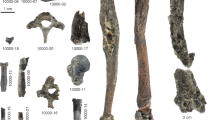Abstract
The hypothesis is advanced that the habitual adoption of the bipedal stance and of bipedal locomotion in the hominids arose from the development of a defence mechanism, namely, the throwing of stones. It is argued that for stone-throwing to become an effective weapon, modifications to the whole post-cranial skeleton and musculature, as well as to the central nervous system are required; including the development of a low centre of gravity and a «launching platform» of relatively high mass. It is represented that hominids, from the earliest Australopithecines to modern man, exhibit modifications to the post-cranial structures that are more consonant with this hypothesis than with the interpretation that the modifications were directed initially and principally towards bipedalism. Such an interpretation is shown to create several anomalies which disappear when viewed in the context of the stated hypothesis.
The importance of the hypothesis for the evolution of Homo and especially for his brain and higher thought processes is commented upon.
Similar content being viewed by others
References
Bauer H. R., 1977.Chimpanzee bipedal locomotion in the Gombe National Park, East Africa. Primates, 18(4): 913–921.
Bielicki T., 1984.Evolution of the intensity of feedbacks between physical and cultural evolution from man's emergence to present times. UNESCO Expert meeting on the Biological Aspects of Race, Moscow, 12–18 August 1964 (manuscript quoted by Tobias, P. V., 1982.q.v.).
Butynski T. M., 1982.Vertebrate predations by Primates: A review of Hunting Patterns and Prey. Journal of Human Evolution, 11: 421–30.
Calvin W. H., 1982.Did throwing stones shape hominid brain evolution? Ethology and Sociobiology, 3: 115–124.
Carrier D. R., 1984.The energetic paradox of human running and hominid evolution. Current Anthropology 25(4): 483–495.
Dart R. A., 1950.Voluntary muscle in the human body. The double spiral arrangement. British Journal of Physical Medicine, 13: 265–268.
Darwin C., 1871.Descent of Man (2nd Edition, 1913, London, John Murray).
Day M. H. &Napier J. R., 1964.Hominid fossils from Bed I, Olduvai Gorge, Tanganyika. Fossil foot bones. Nature, 201: 967–970.
Day M. H., 1986.Bipedalism: pressures, origins and modes. In: Major topics in primate and human evolution (ed. Wood, B., Lawrence, M., Andrews, P.), Cambridge University Press, 188–202.
Duchenne G. B. A., 1867.Physiologie des Mouvements (cited by Robinson, J. T., 1972q.v.).
Fleagle J. C., Stern Jr J. T., Jungers W. L., Susman R. L., Vangor A. K. &Wells, J. P., 1981.Climbing: A Biomechanical Link with Brachiation and with Bipedalism. Symposium of the Zoological Society, London, 48: 359–375.
Goodall J. van Lawick, 1964.Tool using and aimed throwing in a community of free-living chimpanzees. Nature, No. 4926: 1264–1266.
Goslin B. R. &Charteris J., 1982.The human elbow and knee: Functional relationships and phylogenetic considerations. Human Biology, 54: 491–500.
Hurov J. R., 1982.Surface electromyography of superficial back muscles in human children. Functions during vertical climbing and suspension and implications for the evolution of hominid bipedalism. Journal of Human Evolution, 11: 117–130.
Kortlandt A., 1980.How might early hominids have defended themselves against large predators and food competitors? Journal of Human Evolution, 9: 2, 79–112.
Lovejoy C. D., Kingsbury G., Heiple, K. G. &Burstein A. H., 1973.The gait of Australopithecus. American Journal of Physical Anthropology, 38: 757–780.
Lovejoy C. O., 1981.The Origin of Man. Science, 211: 4480, 341–350.
New York Times, September 9th 1974 (cited in The Complete Book of Baseball, ed. Brown, G., 1980, New York, Arno Press).
Poirier F. E., 1977.Fossil evidence — the Human, Evolutionary Journey. Saint Louis, C. V. Mosby.
Prost J. H., 1980.Origin of bipedalism. American Journal of Physical Anthropology, 52: 175–190.
Robinson J. T., 1972.Early hominid posture and locomotion. Chicago/London, Chicago University Press.
Robinson J. T., Freedman L. Y., Sigmon B. A., 1972.Some aspects of human bipedality. Journal of Human Evolution, 1: 361–369.
Rose M. D., 1984.A hominine hip bone, KMN-ER 3228, from East Turkana, Kenya. American Journal Physical Anthropology, 63: 371–78.
Stern Jr. J. &Susman R., 1983. The locomotor anatomy ofAustralopithecus afarensis. American Journal of Physical Anthropology, 60(3): 279–317.
Tobias P. V., 1982.Man the tottering biped. New South Wales Committee in Postgraduate Medical Education, University of New South Wales.
Washburn S. L. &Howell F. C. 1960. Human evolution and culture. In: Evolution after Darwin (editor Tax, E.), 2, Chicago, Chicago University Press.
Weiner J. S., 1973.Charles Darwin's Descent of Man—after 100 years. In: Human Evolution (ed. Day, M. H.), Symposium of the Society for the Study of Human Biology, 11: 1–12.




